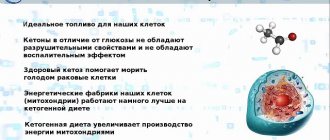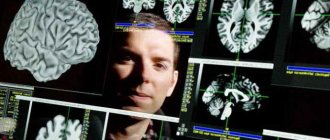Lennox-Gastaut syndrome is a form of generalized (widespread) epilepsy, manifested by various seizures, delayed psychomotor development and specific changes in the electroencephalogram (EEG). This syndrome is often symptomatic, i.e. it is one of the signs of another condition – encephalopathy.
The causes of brain damage in a child - and Lennox-Gastaut syndrome first manifests itself in childhood - can be:
- congenital malformations;
- infections suffered in utero and in the first days of life;
- injuries during childbirth and others.
Unfortunately, sometimes the origin of encephalopathy cannot be determined. The presence of various forms of epilepsy in the family occurs in 2.5–40% of cases. Often another severe neurological disorder, West syndrome, evolves into Lennox-Gastaut syndrome. In addition, parents may notice a child's developmental delay even before the first seizures appear. However, there are also cryptogenic forms of the disease (the cause is not clear), when children do not show any abnormalities until the first manifestations of the syndrome - usually at the age of 3-5 years.
Disease history
In 1939, specialists were the first to highlight and describe in detail EEG changes, which represent a rather slow diffuse manifestation of activity, which corresponds to a frequency of 2 Hz.
These changes in the scientific community received a special name - petit mal. By the middle of the last century, foreign experts had identified a whole series of epileptic paroxysms, which were defined as an independent syndrome, which determined the specific criteria by which patients were diagnosed with epilepsy. Much later, the name in question was introduced for the childhood form of encephalopathy, the symptoms of which were often observed in the periods between attacks.
This pathology is today a fairly common form of childhood disease; according to information from various sources, it can be observed in 3-11% of all recorded cases of epilepsy diagnosis in children.
Boy with Lennox-Gastaut syndrome
Clinical picture
In the vast majority of cases, the disease begins to manifest itself in children aged 1-7 years; the disease is characterized by various paroxysms, which can differ not only in their nature, but also in the frequency of manifestation. Most often, all of them are recorded during wakefulness; in some cases, during the period of awakening, during sleep and during active wakefulness, they actually do not arise.
Over time, experts began to distinguish various forms of this syndrome. One of them is the cryptogenic variety, in which, before the onset of the disease, the child grows healthy and develops normally.
The symptomatic form begins to appear after receiving serious brain injuries or if, even before the onset of the syndrome, a lag in mental development was recorded. The symptomatic type of the disease is much more common; in general statistics it is recorded in 75% of cases if the child has been diagnosed with the pathology in question.
This syndrome is considered one of the most severe forms of epilepsy, mainly because it is very difficult to cure.
Today, developments continue, and experts are forming new therapeutic techniques to help sick children. The first attacks can be recorded at any age from 2 to 6 years, but in most cases it occurs at 5 years.
From this moment on, a delay in general development begins to be observed; at school age, sick children often experience difficulties with the curriculum, sometimes this takes on an extremely severe form. At the same time, behavioral disorders may occur.
The situation is complicated by the fact that each child exhibits an individual reaction to Lennox-Gastaut syndrome and it is often quite difficult to predict the further development of events. Sometimes therapeutic practices are highly effective, significantly reducing the number of attacks that occur, but in some cases they are powerless.
In some cases, attacks are accompanied by severe convulsions; over time, problems associated with the thinking process begin to be observed, and development gradually stops.
More information
Experts agree on the specificity, frequency and memorable nature of the attacks they see. But when it comes to the type of seizure, opinions begin to differ.
. In fact, it is common for them to be brief and even go unnoticed.
Another constant is the usually severe mental changes observed in the patient, both in intelligence and personality. Mental retardation will persist or worsen in most cases
. It is usually associated with cerebral atrophy, which can be confirmed by gaseous encephalography or tomodensitometry.
However, learning disabilities appear to be associated with seizure frequency, the presence of prolonged confusional states in the form of status epilepticus, and psychotic symptoms. The patient's mental state is often influenced by prepsychotic or psychotic personality changes and autism.
Causes
The exact causes that cause Lennox-Gastaut syndrome in children have not yet been studied and established. In some cases, according to experts, this disease arose due to the following factors:
- reduced amount of oxygen that the fetus received during pregnancy;
- lack of weight in a newborn, often caused by premature birth;
- severe brain injuries that were inflicted on the child during pregnancy or during birth;
- transmission of infectious diseases that can affect the brain, for example, meningitis or rubella;
- convulsive reactions that began during infancy;
- a number of diseases, including tuberous sclerosis or cortical dysplasia.
Pathogenesis of the disorder
Although the first symptoms appear in children aged two to eight years, there is a separate focus group of patients in whom
the disease manifests itself at 4-6 years of age.
In some cases, the disease transforms from West syndrome, which is diagnosed in children under one year of age. Then the syndrome will develop according to one of the scenarios:
- infantile spasms of West syndrome are replaced by tonic attacks, skipping the latent form and turning into Lennox-Gastaut syndrome;
- infantile spasms of West syndrome disappear, and psychomotor development improves.
Complex of provoking factors
To date, the specific causes of this type of epilepsy are not known. Risk factors include:
- oxygen starvation of the fetus in the prenatal period;
- damage to the child’s brain during the prenatal and natal periods - premature birth, physiological underdevelopment;
- infectious brain lesions due to rubella, encephalitis, meningitis;
- cortical dysplasia - a disorder of the structure of the cerebral cortex;
- Tuberous sclerosis is a benign tumor in a variety of tissues and organs.
- idiopathic factor - the disease develops for unknown reasons;
- genetic predisposition.
Manifestations of the syndrome
Lennox-Gastaut syndrome can be characterized by a wide variety of types of paroxysms, which may differ from each other, both in the frequency of manifestation and in the characteristics of attacks.
Tonic seizures
This type refers to manifestations that last a short period of time, on average 10 seconds, but can reach one minute. At this time, a disturbance of consciousness may be recorded. In turn, there are a number of subtypes of tonic seizures:
- Axial tonic paroxysms, the main manifestation of which is the sudden tension of a whole group of muscles located in the back of the cervical region, back and abdomen. A spasm occurs, which dramatically changes the body posture, as well as the child’s facial expressions. The head rises up, the eyes and mouth open and remain in this position for a certain period of time. Also very often there is a cessation of respiratory movements.
- The manifestation of axorisomelic seizures occurs due to the transition to a state of strong tension of the entire group of muscles responsible for the functioning of the hands. Outwardly, this manifests itself in the form of convulsive movements of the shoulders or strong abduction of the forearms back.
- An ordinary tonic convulsive manifestation is expressed in a change in the person’s body posture during a seizure. At the same time, he can bend his forearms, clench his fists, straighten his legs, or, conversely, bend them strongly. Regardless of the type of tonic attack, it usually involves a disturbance in the rhythm of the heartbeat, a change in complexion, the release of tears and a stop in the movements responsible for breathing.
Atonic attacks
This type of attack is even more short-term; they usually do not exceed 4 seconds. During an attack, sudden falls of the patient are possible, but they can also occur in a milder form, expressed only in the form of twitching of the head or bending of the legs.
Falls are not uncommon, so such attacks often pose a risk of injury. If the patient was diagnosed with Lennox-Gastaut syndrome, then the falls are sudden and instantaneous; with other types of epilepsy, all falls appear much more slowly.
Myoclonic seizures
Such attacks occur at lightning speed, for a period of 1-3 seconds, bringing various muscle groups into a state of excitement, causing them to make voluntary movements. More often, various muscle groups responsible for the movements of the arms and legs are affected.
With the syndrome under consideration, such attacks are monotonous and regular; they must be distinguished from similar seizures not associated with epilepsy. Spontaneous myoclonus usually occurs during sleep and is irregular in nature; it can be triggered by sound, tactile or light stimuli, without any special changes that could be recorded by the EEG.
Atypical absence seizures
They represent a temporary numbness that can last from 5 seconds to half a minute, and the patient’s consciousness may be disturbed. Atypical absence seizures are characteristic of Lennox-Gastaut syndrome; in other forms of epilepsy they are observed much less frequently. They are often combined with dysfunction of certain muscle groups or a general decrease in muscle tone. Usually appear after the patient awakens from sleep.
Classification and characteristic signs of the disease
Lennox-Gastaut syndrome can have a different clinical picture. It depends on the type of lesions of the central nervous system and the reasons that caused their formation. It is customary to distinguish several types of symptoms:
- Atonic seizures are accompanied by loss or severe decrease in muscle tone. The patient is unable to control his own movements. If the attack lasts several seconds, it may remain invisible to others, which is especially dangerous in young children who are not able to talk about what happened. Loss of consciousness and falls are common during atony.
- Myoclonic paroxysms are characterized by specific muscle contractions that look like twitching of the limbs and torso. They are characterized by symmetry, that is, both halves of the body are affected at once. A distinctive feature is the stereotypic nature of the patient’s movements. When the legs are involved in the pathological process, children and adults fall, which provokes injuries.
- Tonic attacks do not last long and are often recorded at night. This makes it difficult to differentiate them from another form of epilepsy - pseudo-Lennox syndrome, which is accompanied by pathological electrical activity of the brain during slow sleep (ESES - “electrical status epilepticus during slow sleep”). Unlike the latter, no specific paroxysm is detected in the process of taking an electroencephalogram. Tonic seizures are short-lived. They are dangerous due to loss of consciousness, autonomic disorders and respiratory arrest.
- Atypical absence seizures are one of the main signs of Lennox-Gastaut syndrome. There is a partial disturbance of perception. Patients become immobile for a short period of time. Motor manifestations are different: from atony to hypertonicity of individual muscle groups. When similar signs of Lennox-Gastaut syndrome occur in children, they often go unnoticed because they last only a few seconds.
- Delayed psychomotor development accompanies many mental disorders. It represents the patient's inability to remember new information and learn skills. Children have difficulty mastering spoken language and school discipline. Adults with Lennox-Gastaut syndrome also show signs of developmental delays, which also affect socialization. Such a person is incapable of self-care and needs outside help. Although adaptation is possible, it can only be achieved in 15% of cases.
Diagnostics
Treatment is preceded by a thorough diagnosis; at the initial stage it consists of a conversation between a specialist and the child’s parents, the main goal is to clarify the following questions:
- the period when the child had his first attack;
- the number of attacks suffered and their frequency;
- duration of symptoms;
- the child has any serious illnesses (if the answer is positive, information is required about all the medications he has taken or is taking);
- presence of head injuries that could lead to brain damage;
- the presence of complications that accompanied the birth process;
- child's problems in the educational process;
- possible behavioral disturbances.
Diagnosis of Lennox-Gastaut syndrome
In order to record and confirm the presence of Lennox-Gastaut syndrome in a child, a specialist carries out assessment and analytical activities according to three criteria:
- the type of attacks that occur and how difficult they are to treat;
- the presence of delays in mental development and general disorders associated with mental activity;
- Electroencephalography data showing the full picture of changes or disturbances in brain wave frequencies.
Treatment
Treatment for this disease involves medication, surgery, and diet.
Drug treatment
In most cases, patients are prescribed various medications that suppress the signs of epilepsy. The main task of a specialist is not only to reduce the frequency and number of seizures, but also to select a medicine that will cause a minimum number of side effects.
Determining the most effective and appropriate treatment for a given disease often takes a significant amount of time. This is due to the difficulty of finding out the causes of the syndrome; in 40% of cases its appearance is not preceded by any other diseases.
The most commonly prescribed drugs include:
- valproate, vigabatrin and ethosuximide, which are always the first choice for this diagnosis;
- if the effectiveness of these drugs is low, corticosteroids are prescribed;
- Clobazam, rufinamide, and topiramate are also common treatments for Lennox-Gastaut syndrome.
In most cases, to achieve a positive effect, a combination of several drugs is required. However, not all of them are compatible with each other, so this decision can only be made by the attending physician.
Diet
To treat Lennox-Gastaut syndrome, a ketogenic diet is often used, which has proven effective in a number of cases. Its main principle is to reduce the amount of carbohydrate consumed, while it is necessary to take more food with a significant fat content.
During the diet, it may be necessary to change the doses of medications that the patient takes, so the attending physician should be informed about adjustments in the diet.
Drug therapy
The goal of therapy is to reduce the frequency of attacks. The drugs are selected individually, taking into account the minimal occurrence of side effects.
The following anticonvulsants are prescribed:
- Clobazam;
- Rufinamide;
- Sodium divalproate;
- Lamotrigine;
- Topiramate;
- Depakine;
- Carbamazepine;
Article on the topic: Diagnostic laparoscopy of the abdominal cavity - indications for performance
Often, the use of one product does not give the desired results. The drugs are prescribed in a comprehensive manner, and the intake is strictly controlled by the attending physician.









